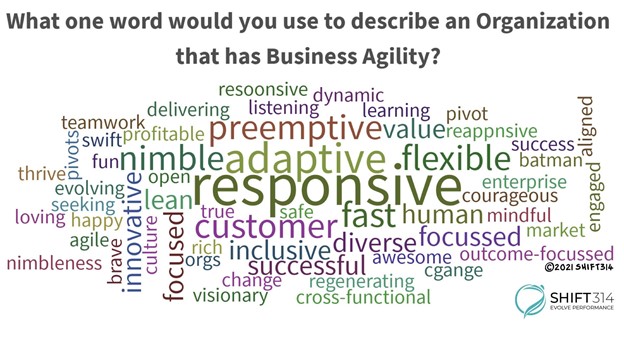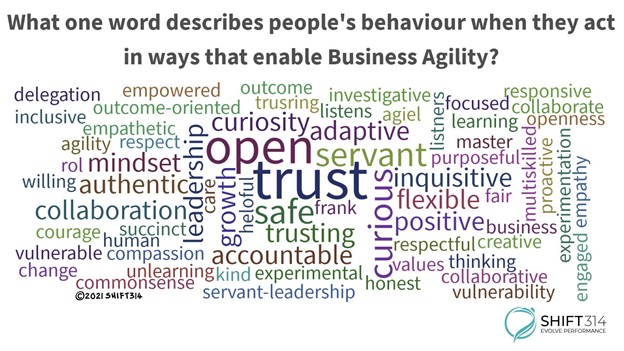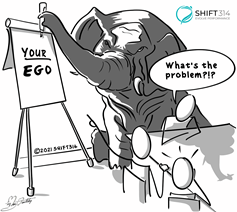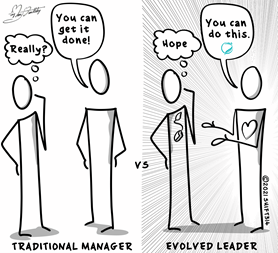Transformation & Change108
Business Agility is a Transmission
Michael K Sahota
November 8, 2021
Michael K Sahota
November 8, 2021
Business Agility: it's not what you think. Business Agility is defined as a business that has the characteristics of agility: it's flexible, adaptable, and responsive to the context in which it's operating. It has the characteristics of robustness and survivability.
 A crowdsourced definition of Business Agility, 2019 at Michael K. Sahota speaking event:
A crowdsourced definition of Business Agility, 2019 at Michael K. Sahota speaking event:
Here’s what most people miss: Business Agility has nothing to do with Agile or an organizational transformation. Business Agility is not about structures and processes. Business Agility is achieved when there is the capacity to thrive in uncertainty, deliver products faster while creating engaging, healthy workplaces. It's about a culture of collaboration - a shift in mindset and behaviours. Business Agility can only be created by the people.
Our view is that Business Agility is an emergent outcome that depends on the evolution of the people in the organization. The adaptability of an organization is directly related to the adaptability of the people. A traditional, “business as usual” organization can’t have agility when its people don't have the characteristic of being adaptable. It’s not about Agile.

It’s about people growing and evolving so they exhibit these characteristics and behaviors. So the limiting factor for Business Agility is the rate of evolution of all the people in the organization.
To create an organization that has Business Agility, it’s essential to create an organization where people are learning, growing and evolving.
We find that the most important factor to creating an organization that has Business Agility is leadership. Leaders are imperative because they are responsible, model and hold the cultural template of the organization. Leaders create safety, model adaptability and make the “rules” for what behaviours are acceptable within the organization. People will be influenced, mentored by and follow what the leaders do.
The only way for a leader or change agent to lead a journey of evolution to business agility is for them to undertake their own evolutionary journey. This journey is a transformational one, it includes how you evolve as a leader, your behavior, your mindset and your tactical, practical, day-to-day ways of operating with agility. It's a journey of self awareness, one that can only be achieved by a shift in consciousness.
People are the foundation of Business Agility. Your organization is only as adaptable as the people in it. To grow and guide people on their evolution, it’s worth asking, is this person adaptable? How well do they thrive in uncertainty? How are they showing up moment to moment: engaged, motivated and collaborative? Does this person have the characteristics of agility?
Most people have heard of Carol Dweck’s “Growth Mindset.” That’s a good starting place: it means that people are ready to learn new things and are willing to learn about how to function better in the organization. While a growth mindset is a good starting place, we’ve extended the notion of the “growth mindset” to that of an “Evolutionary Mindset.” An Evolutionary Mindset is the step beyond just growth to where people are ready to learn about themselves, their behaviors, perceptions,etc. as human beings - to work through their areas of challenge. One might be open to learning externally, but self-awareness and self-investigation is another level altogether.
 Sure, people are ready to show up to a retrospective to make things better, yet are they ready to look inwards to investigate how they are contributing to challenges?
Sure, people are ready to show up to a retrospective to make things better, yet are they ready to look inwards to investigate how they are contributing to challenges?
Having an Evolutionary Mindset describes somebody who says, "Yes, I'm ready to look at how I'm showing up and I'm ready to evolve myself."
People in an organization with Business Agility are able to navigate uncertainty and show up engaged and motivated no matter what is going on around them. They’re able to have healthy relationships, regardless of what position they’re in.
As leaders of organizational systems, we are the ones creating the environment. When we have a high level of psychological safety, we are able to transmit it directly to others. Having psychological safety also allows us to surf the waves of uncertainty. We can stay calm and fully resourced to create an environment for others where they can reach their full potential. This is the “How To” create an organization that can achieve Business Agility. The source of Business Agility is the people, and their inner state of psychological safety plays a key role in this. Without an inner shift it’s not possible to surf the waves of change.
However, psychological safety is only the first step; because leading Business Agility is about behaviours, an essential key for leadership is the dissolved ego. A dissolved ego is the foundation of your willingness to create leaders around you, to let go of your need for importance. A dissolved ego gives you the stable inner presence that has the ability to remain calm during a crisis. To be calm during the storm and maintain the intelligence to make quick decisions while facing uncertainty, pressure or crucial issues.
A dissolved ego also allows for untriggered behaviours when working with others. It gives you the inner strength and the courage to speak up, to have the crucial conversations with the employees that are disengaged or are blocking projects. Having a dissolved ego helps you address these psychodynamic relationships and situations head-on so that they don’t create a ripple effect down the road and block the high performance of the organization.
 We are speaking of a very different kind of leadership than previously proposed models … an evolution of previous models such as Servant Leadership and Transformational Leadership. While these have been partly helpful, they are incomplete and have proven insufficient to create Business Agility.
We are speaking of a very different kind of leadership than previously proposed models … an evolution of previous models such as Servant Leadership and Transformational Leadership. While these have been partly helpful, they are incomplete and have proven insufficient to create Business Agility.
The SHIFT314 definition of Evolutionary Leadership is:
Evolutionary Leadership is the choice to evolve oneself and develop the capabilities needed to evolve an organization.
Our book Leading Beyond Change: A Practical Guide to Evolving Business Agility goes into detail, giving the business patterns, the “how to” for moving from a more traditional, structured way of working to more evolutionary ways of working, to create an organization that is highly adaptable. The book maps out the shift needed to lead or start the journey of Evolutionary Leadership.

What's required to lead Business Agility is a shift of mindset, worldview and perceptions. We describe it as a shift of consciousness where we see ourselves and others differently and the behaviours that reflect this more unified worldview.
It’s all about moving to a dissolved ego and an ability to put aside our own self-interest for the needs of the people around us and the needs of the organization. That's what's going to allow us to build other leaders.
The powerful metric of success for a leader is their ability to develop other leaders around them. When you have leaders who are able to build leaders beneath them, the cascade down creates leaders at all levels. People show up fully - mind, body, heart, spirit - and that gives the organization the fire it needs to move, to shift, to grow, and to adapt. Building leaders at all levels will yield the fruit of Business Agility.
What we share here is something anyone can do, at any level of the organization, in any role - without power, authority, or budget. We can't control what anyone else does, yet we can control ourselves. And when we choose to put effort into our evolutionary journey, results come. This is what we see consistently with leaders we've trained around the world and in the organizations we've worked with. Here are five practices that anyone can start doing now to create Business Agility.
Our core message is to “put the oxygen mask on yourself first.” Most often, people focus on helping and mentoring others. However, the real secret of Evolutionary Leaders is that they focus on their own growth, their own evolution, their own shift of consciousness.
Everyone that's reading this article now is somewhere on their journey of evolution. The most important characteristic, which is what we use to define
Evolutionary Leadership is The Choice to Evolve Oneself
It doesn't matter where you are now - as long as you're willing to grow further. Develop your evolutionary mindset. Make the choice to ask yourself, how can I improve, to improve the situation?
Developing a higher level of self-awareness is the first step. I say “higher” because no one has the highest level of self-awareness; there's always growth happening. Ask questions like, how am I showing up? How are my behaviors impacting others? What is my emotional state moment to moment? How resourced am I? Am I always showing up in solution mode? What is my level of psychological safety? Where are the places where I'm showing up in my bad habits?
Where am I blaming the outside world, somebody else, the process, or the structure? Where can I do a better job asking for help for others? Am I modeling learning by admitting my errors and learning from them and sharing that with others?
Self Awareness IS the Technology for Shifting Consciousness
It is essential to have the ability to navigate uncertainty. This means not having a fearful or anxious inner state. It means having patience, and not pushing for results. You're working with the system and the people to flow with the situation and create openings where solutions emerge.
Getting more comfortable with uncertainty is a basic premise of Agile. “Responding to change over following a plan,” and getting really comfortable with uncertainty in all aspects of our daily life and experience is an essential part of leading Business Agility. The ability to navigate uncertainty starts with your level of psychological safety and from there moving away from traditional fear-based structures and practices to learn a new way to lead.
Another important aspect is a willingness to put aside our own ideas, our own models, and our own thoughts of what's correct to create a space for others to contribute. That's what will actually build leaders around us. Live in the mantra, “How can I help you be successful?”
When we live to help others be successful this opens opportunities to connect, collaborate, to build relationships and trust. Oftentimes we are focused on what we can get, or focused on our own success. This behaviour creates damage and we lose our way. Spending every moment on helping others be successful will enhance your leadership, your position and who you are as a person. You will automatically grow and evolve.
Genuinely caring about other people is essential. That might sound strange, because everyone feels like they care about people. Yet it’s really about every single moment, you’re aware of how your conscious and unconscious behaviors and thoughts are affecting people - Are you making an effort to have a positive impact?
Everything you do counts, and it will either uplift people or drag them down. Start to be aware of how you are impacting people. Am I uplifting people? Am I internally judging people while I'm pretending to be nice or caring? Am I being authentic?
When was the last time you apologized for your behavior? If you're a normal human being, you’ll make lots of mistakes. And if you’re a really good leader, you'll be apologizing regularly.
Making amends lets people know that you care, that it’s okay to make mistakes, and that whatever behavior you demonstrated isn’t what you want to cultivate in the organization. We can't change all of our conditioning and behaviors in an instant, yet when we start to have awareness and start to take responsibility for them, we can transform what we have into gold.
Live your life in the mantra “How can I help you be successful?”
Focus your attention on guiding or helping others be successful. This will shift your role in any organization. You will build relationships, trust and this way of being will guide you in every moment, giving you a road map to building your team, your organization and any system you function in.
As an Evolutionary Leader, you're modeling the behavior that you want to see in others. The first step is your own personal transformation. There is no way you can transform anything else unless you've gone on the journey of transformation yourself. The insights from that journey are what give you the ability to help people and organizational systems to navigate transformation.
 Through our own evolution, we can become a living transmission of Business Agility. The most powerful thing you can do to lead others on a transformational journey is to show up in a transformed way.
Through our own evolution, we can become a living transmission of Business Agility. The most powerful thing you can do to lead others on a transformational journey is to show up in a transformed way.
However, this transmission is non-tangible. It's not something that can be seen, because it isn't your behavior, it isn't the words that you say, it isn't how you're showing up at a meeting or how you're creating processes for an organization. It's actually something that you have lived and experienced that is anchored into the very fabric of your being. It emanates from you, creating a ripple effect into every organization that you're around. People try and talk about it with words like charisma and presence but it runs much deeper than that.
Let’s take the example of inviting people to a meeting. The meeting's not mandatory, it's invitational, you can show up if you want to. Yet, there's an aspect of that leader that's inviting you to the meeting that gives you the sense it's not optional. There's an aspect of their being that's commanding you to show up at that meeting or else.
These are the metaphysical aspects of our humanness that we can feel from one another. And so it doesn't matter what you're saying, what’s more important is what you're transmitting to the other people within the organization. Leading an organization into Business Agility means first going on that journey yourself.
Change is only possible to the extent that leaders hold the transmission (consciousness) of an evolved organization.
A graduate of our training, who is the director of an organization, had an almost impossible target to meet: to triple their rate of productivity by taking a project down from three years to one year. There was no way his group of 100 people could meet it.
He did what we're talking about here: he was honest with himself, he looked at the truth of the situation. He admitted what was going on and asked for help.
He said, "Look, we've got this unsolvable challenge as a group. If we don't succeed with this, we're all out of our jobs, including me. I'm not saying this to scare anyone. I'm just saying, I think we're smarter together. Let's all put our heads together to figure out how we can triple our rate of productivity."
They worked on it together and said, "Look, we just need to admit our challenges to each other and learn like we've never learned before. If we can learn how to do our jobs really well, we'll be able to reach that level of productivity." They found a solution to teach each other the skills they needed, no extra budget, no outside contracts.
What happened? They didn't deliver the product in a year. They delivered it in 10 months, and $700,000 under budget!
This is what we're talking about. How a transformed leader can create a context and an environment for the extraordinary to happen. Business Agility is not a structure or a framework, it is about people who show up with the adaptability to successfully navigate complex organizational issues and create high performance.
He describes that, before going on an evolutionary journey, “I would have been shut down, I would have been in commanding control. I would have been in so much fear about my job that I wouldn't really care about other people, how this happened, how to get it done, and I would have created so much damage. I took a chance and I became very vulnerable, more vulnerable than I've ever been. I had the courage to try this new approach. And that was the key.”
This is what Business Agility means. How flexible are you? What type of challenge can you overcome instantaneously? It takes a whole team. It takes an Evolutionary Leader (or lots of them!).
Business Agility is an emergent journey that depends on the evolution of all the people in the organization. As leaders evolve themselves to better model adaptability and other characteristics of an evolved organization they are able to accelerate the journey. Change is only possible to the extent that leaders hold the transmission (consciousness) of an evolved organization. As such, Business Agility is ultimately dependent on the evolution of leaders. Business Agility is a transmission. In this way, Business Agility is an emergent outcome that depends primarily on one factor: the rate of evolution of the leaders.
Please subscribe and become a member to access the entire Business Agility Library without restriction.